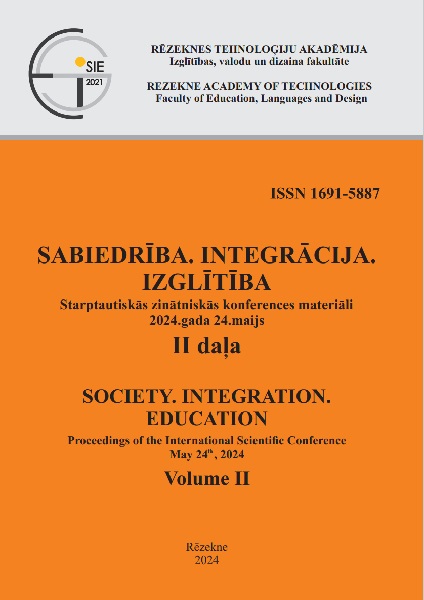POSSIBILITIES AND POTENTIAL OF PROMOTING A MICROENVIRONMENT BASED ON A CULTURE OF PEACE IN EDUCATIONAL INSTITUTIONS
DOI:
https://doi.org/10.17770/sie2024vol2.7888Keywords:
culture of peace, educational institution, educators, gamification, microenvironmentAbstract
Research reveals that the culture of peace is an actual phenomenon of people's social life, which is not only an approach to the prevention of violence and an alternative to the culture of war and violence but also creates a society that is probably only talked about in the context of utopia. In 2024, of course, it is not worth dreaming about utopia, however, educating the teaching staff about a micro-environment based on a culture of peace and its influence on the organization's operation contributes to the achievement of the goals of the learning process and a human-centered work environment. At the same time, an influential educational resource on cooperation and conflict resolution, decision-making, all human rights, communication, and information exchange is being developed. The publication highlights the possibilities of promoting a microenvironment based on a culture of peace, using the gamification process, and its pedagogical and psychological possibilities in improving the microenvironment of educational institutions in Liepāja, describing the empirical experience from case studies where was survey and game “Peace Please” sessions. The study aims to analyze the possibilities of using the gamification process based on the culture of peace in improving the microenvironment of educational institutions in Liepāja. The study results provide information about the game "Peace, please!" possibilities of use in educational institutions, indicating the essential thing common to the culture of peace and the organization's microenvironment. Problems specific to the micro-environment in educational institutions are identified and solutions are proposed for promoting a micro-environment based on a culture of peace.
References
Armstrong M., Tailor S., (2014). Armsstrong`s handbook of human resource managment practice. Ashford: Colour press Ltd.
Elise B., (2008.) Peace Culture. No: Encyclopedia of Violence, Peace, & Conflict (Second Edition) Academic Press, pp. 1452 – 1465. doi.org/10.1016/B978-012373985-8.00123-9
Kotler P., Armstrong G. & Opresnik M.O. (2018) Principles of Marketing 17e Pearson Education Limited
Nussbaum, M. (2011). Creating Capabilities: The Human Development Approach. Cambridge, MA and London, England. Harvard University Press. https://doi.org/10.4159/harvard.9780674061200.
Praude V., & Beļčikovs J., (1996) Menedžments. Teorija un prakse. Rīga: Izdevniecība Vaidelote.
Rodríguez-Martínez, C., & Calvo, G. (2014). Gender and positive social interaction at school: a proposal based on the culture of peace and the capability approach. Procedia-Social and Behavioral Sciences, 132, 107-113. https://doi.org/10.1016/j.sbspro.2014.04.285
UN, "Declaration and Programme of Action on a Culture of Peace", resolution 53/243, p. 2, General Assembly, 93rd session, Oct. 1999, UNESCO. Yin R.K., (2009) Case study research 4`th edition. SAGE Inc.






